
Children in the Dark
"We talk with indignation or enthusiasm; we talk about oppression,
cruelty crime, devotion, self-sacrifice, virtue, and we
know
nothing
real beyond the words" (76).
Joseph Conrad's "An Outpost of Progress" (1897)
“Preface to The N--er of the Narcissus” (1898) / PDF
- does Conrad set the artist and scientist at loggerheads with one another?
- to what qualities in the audience does the artist address him/herself, according to Conrad?
- does Conrad believe that art serves a socially unifying or fragmenting function?
- is Conrad elevating or disparaging undeveloped countries in the following declaration? "[T]here is not a place of splendour or a dark corner of the earth that does not deserve, if only a passing glance of wonder and pity" (1).
- why might Conrad appear to value temperaments, emotions, and the senses more than thought and reason?
- what "truth" does Conrad believe the fiction writer should pursue?
- what response does Conrad offer to those seeking didactic or entertaining literature?
- is Conrad an advocate of Realism, Romanticism, or Naturalism?
- Towards the end of his essay, Conrad concocts a hypothetical scenario about a menial laborer whose efforts fail at some physical task to provide a picture of the challenges facing the fiction writer. Does this scenario also capture key features of Conrad's own stories?
- does Conrad believe that Art compels humans to look towards the future, the past, or the present?
Joseph Conrad's "An Outpost of Progress" (1897) in Tales 63-84 (or 93-126)
- do you imagine that either “Makola” or “Henry Price” is the true name of the black man from Sierra Leone hired to run the trading station’s storehouse?
- does Conrad forward a particularly optimistic, or pessimistic, vision of human nature in this novel?
- do Kaverts and Carlier complement one another well; are they, together, an effective team?
- identify an example of the director’s “grim humour” (64).
- with what tone does Conrad describe Gobila and his religious views?
- how does the camaraderie of Kaverts and Carlier morph over time?
- according to Conrad’s narrator, our individual sense of identity leans most heavily on what factor?
- does the colonialist project injure the colonialists as much as the colonized?
- in what ways do Kayerts and Carlier backtrack on their flimsy principles about the horrors of slavery?
- trace those moments where objective narration dips into sarcasm.
- why does Kayerts decide not to give the sugar to Carlier, only an instant after deciding to relent?
- on what subjects is the narrator willing to declare his opinion without equivocation?
- what immediately happens after Kayerts cries for God to help him (82)?
- what use does Kayerts make of the cross over the grave of the station’s first chief?

Black and Violet (1923)
Wassily Kandinsky
Dr. Paul Marchbanks
pmarchba@calpoly.edu
![]()
